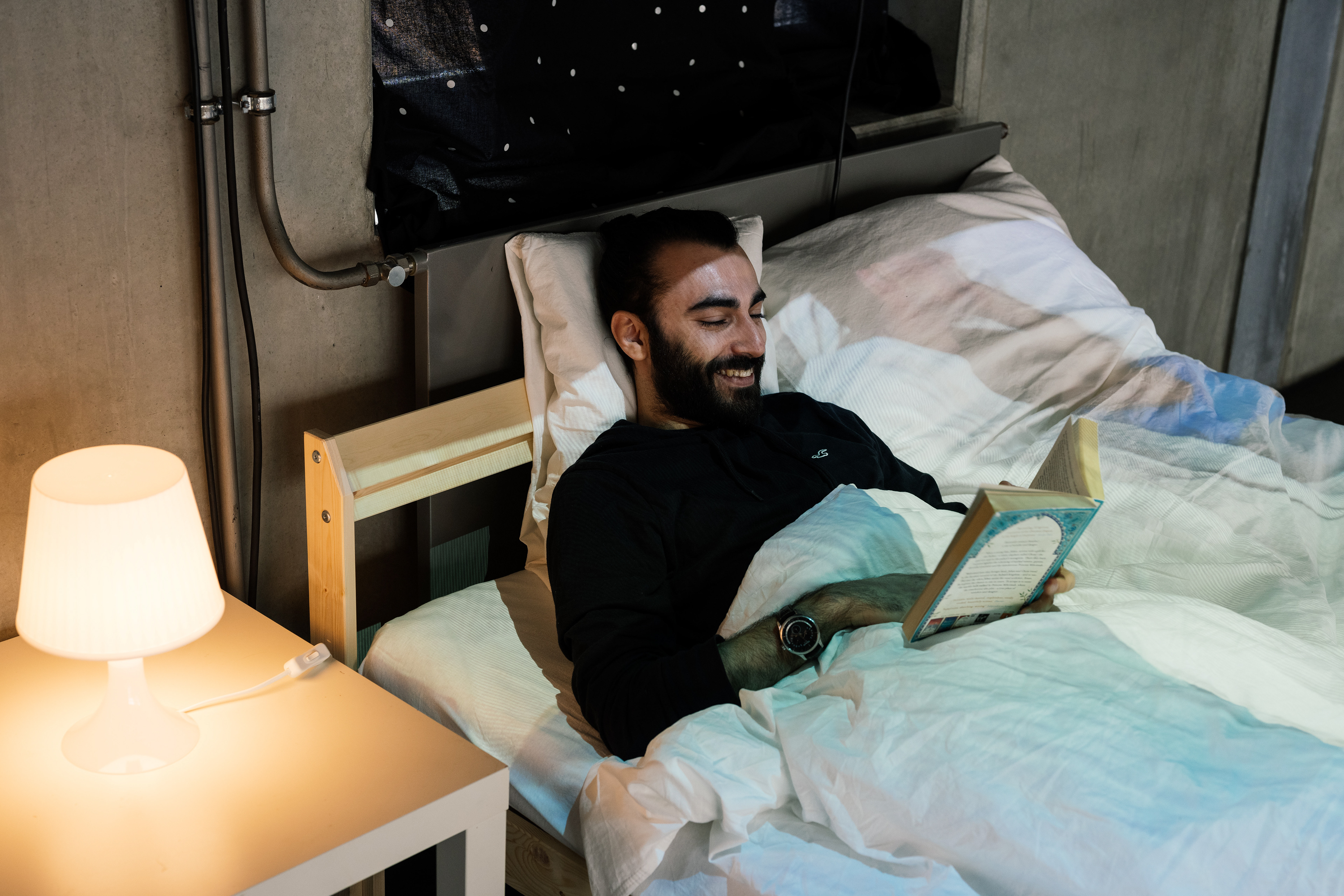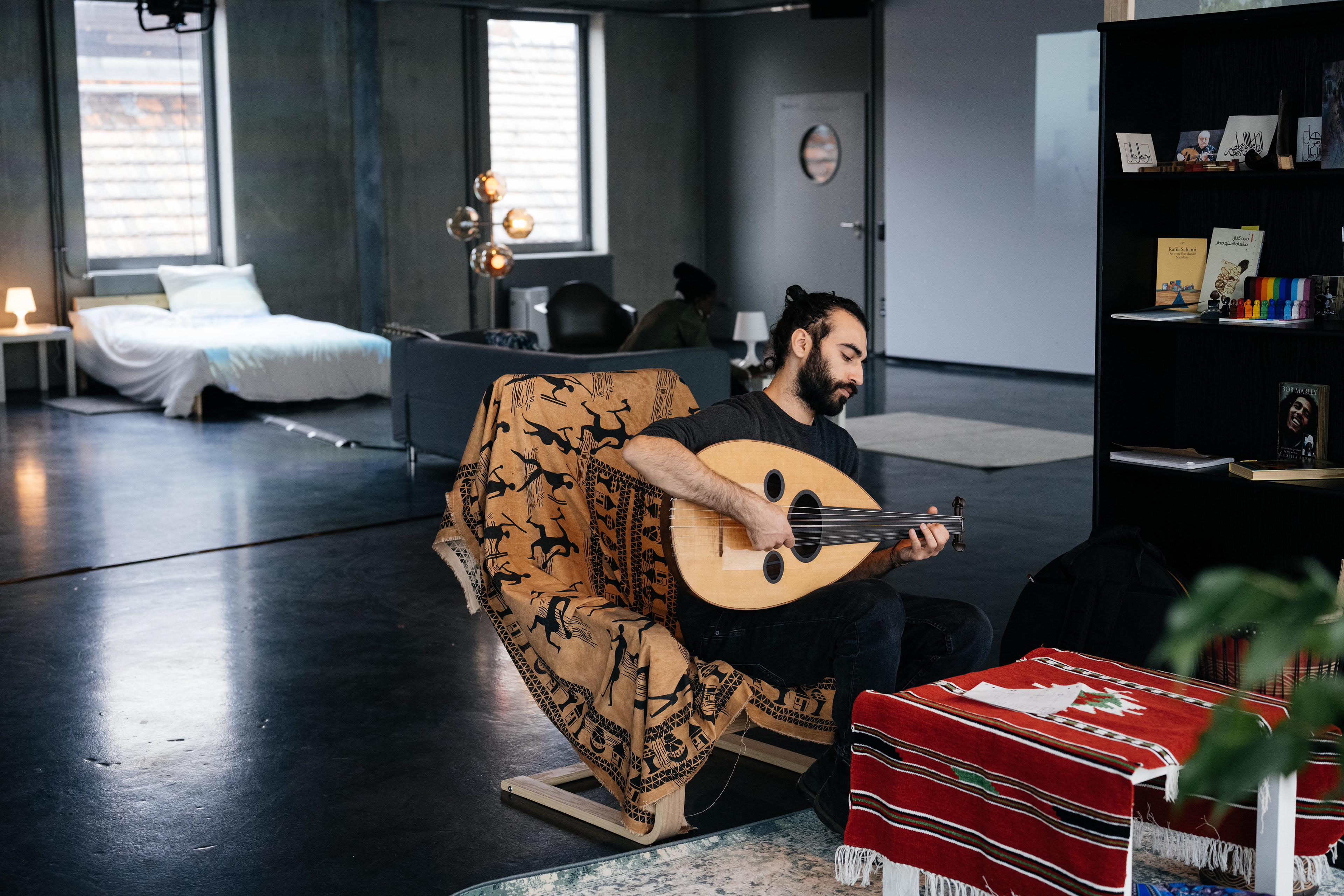Three performers,
Three separated lives,
Simultaneously, they showed together.








Exhibition Hall Theme: "A Migrant's Home"
Setting: The exhibition hall is designed to resemble a typical migrant's home, creating a space that reflects the experience of immigration and cultural blending. The hall is furnished with IKEA furniture, chosen for its universal and neutral design. This choice symbolizes a common international space that does not specifically belong to any single ethnic or national identity.
Decoration: While the basic furnishing is neutral and international, the space is personalized with traditional and ethnic items brought by the performers. These items may include cultural artifacts, personal mementos, photographs, traditional textiles, and other objects that hold significance to the performers' heritage. The juxtaposition of the neutral, modern IKEA furniture with the diverse, culturally rich personal items illustrates the blend of the new and the old, the international and the ethnic, which migrants often experience.
Each performer is encouraged to bring personal and ethnic items from their home. These items will decorate the exhibition hall, giving it a feel of their personal living space. This approach aims to create a more intimate and culturally rich environment.
The Installation has Five Movements:
I. Gastronomy, Smellscape
Engage in activities related to food and cooking.
Create an environment rich in various aromas.
Eat what you have cooked at the dining table.
II. Normal Everyday Life Activities
Read books aloud to create an auditory experience.
Sleep in bed.
Listen to local news broadcasts.
Play traditional music on the phone, contributing to the soundscape.
III. Solo Music Performance
Perform an improvisational piece.
Base the improvisation on the music currently playing in the hall.
IV. Community
Set up a video call with family and friends in the performer's hometown.
This movement emphasizes connection and community ties.
V. Assimilation
Conduct a group jam session.
This movement should represent blending and harmonizing different traditional musical elements and styles.
The Performance Concept: "Simultaneous Lives in a Singular Space"
The exhibition hall is ingeniously segmented to represent a singular apartment space yet simultaneously embodies three distinct living areas. Each area is a separate 'apartment' for the individual performers, symbolizing their unique living experiences.
Despite sharing the same physical space, these 'apartments' are distinct in time and essence, reflecting the performers' lives as if they are living in different places. The uniform IKEA furniture across the hall provides a neutral, international backdrop familiar to all three spaces. However, each performer infuses their area with personal and ethnic items, creating a vivid mosaic of cultural diversity within a shared environment.
This unique setup allows the performers to live out their narratives concurrently, separately, in the designed apartment. It's a visual metaphor for the diverse yet parallel lives of migrants, coexisting in a shared space but maintaining their distinct cultural identities.
Performance Directive: "Isolated Awareness in a Shared Space"
Performers must be aware of a unique aspect of their role: while they can see each other within the shared exhibition space, they should act as if the other performers do not exist. This directive is crucial in maintaining the illusion of separate lives within the singular apartment setup.
Critical Points for Performers:
1- Selective Awareness: Each performer, despite being in the visual range of the others, must carry out their activities independently, ignoring the presence of fellow performers.
2- Audience Interaction: The only permitted performer interaction is with the audience. This interaction is vital as it bridges the gap between the performers' isolated worlds and the exhibition's communal space.
3- Maintaining the Illusion: The performers' ability to act oblivious to each other's presence is essential in creating a realistic portrayal of living separately in the same space. This aspect of the performance highlights the theme of individuality amidst shared environments.
Audience Role: "Guests in the Performers' Homes"
In this unique performance setup, the audience is not merely a spectator but plays an integral role as 'guests' in the performers' homes. This concept transforms the exhibition hall into a more intimate and interactive space, akin to visiting someone's living area.
Guidelines for Audience Engagement:
Welcoming Atmosphere: Each performer's space is designed to be inviting, encouraging the audience to engage as if they are guests visiting a friend's home.
Interactive Experience: Audience members are encouraged to interact with the performers, akin to how guests might converse with a host. This interaction should be respectful and in keeping with the theme of visiting someone's home.
Respect for Personal Spaces: While the audience is invited to engage with the performers and their spaces, they should also be mindful of their personal and cultural items, treating them with respect and curiosity.
Exhibition Concept: "A Fusion of Art Installation and Living Music Piece": This exhibition transcends traditional boundaries, merging the elements of an art installation with the dynamic use of human performers as living objects. It's neither altogether a theater piece nor solely an art installation; it's an innovative amalgamation that uniquely invites audience immersion.
Audience Engagement: Experiencing Immigrant Lives
The audience is invited to step into the role of guests visiting the homes of immigrants. This immersive experience is designed to let them feel the lifestyle and life experiences of the performers, who represent different cultural backgrounds.
As guests, audience members can choose the depth of their engagement. They are welcome to sit down and spend considerable time in each performer's space, absorbing the ambiance and interacting with the performer. Alternatively, they can quickly visit to glimpse each unique living experience.
Flexibility and Interaction: The flexibility of engagement allows the audience to tailor their experience according to their interest and comfort level. This approach encourages a more personal connection with migration, cultural identity, and assimilation.
The performers, acting as hosts in their respective spaces, contribute to the authenticity of the experience, enriching the audience's understanding of diverse life stories.
Compositional Approach: An Intimate Fusion of Sound and Memory
In this composition, I have embraced a philosophy akin to that of Éliane Radigue, known for her deep, meditative explorations of sound. My approach weaves auditory and visual stimuli to create a resonant and evocative environment deeply connected to the performers' cultural and personal backgrounds.
- Soundscapes from Hometowns as Emotional Triggers: Specific sounds from each performer's hometown are central to this composition, reminiscent of Radigue's attention to the subtle nuances of sound. These sounds, ranging from religious chants to the familiar hum of urban life, evoke a sense of place and memory, serving as emotional and performative triggers for the artists.
This technique mirrors Radigue's practice of using sound as a sculptural material, where the auditory elements are heard, felt, and experienced, shaping the performers' improvisations.
- Projected Visuals as Windows to the Past: Complementing the soundscapes are visuals projected onto the walls, akin to looking through a window into the streets of the performers' hometowns. This method draws from Radigue's imagery and visual cues in her compositions, where the visual aspect is as integral as the sound itself.
These projections create a dynamic and interactive backdrop, influencing the performers' movements and emotional expressions, much like Radigue's approach to integrating visual and auditory elements.
- Stage Design Reflecting Immigrant Experiences: The stage is designed to reflect the nuanced experiences of immigrants, blending elements of their cultural heritage with their present realities. This aspect of the composition resonates with Radigue's focus on creating immersive environments that are both reflective and transformative. Including personal and ethnic items in the stage design adds layers of authenticity and depth, creating a space that is a microcosm of the performers' journey between cultures.
- Interplay of Composed Music and Improvisation: The composed music in this piece, played through speakers, sets a foundational soundscape for the performers. This approach is inspired by Radigue's technique of creating a sonic framework for improvisation.
The performers' improvisations, guided by the composed music and sensory stimuli, echo Radigue's structured yet fluid creativity concept. The music acts as a canvas, allowing performers to paint their narratives through movement and expression.
Final Movement: Jam Session with Individual Isolation
The concluding movement of the composition is a jam session that uniquely captures the essence of simultaneous togetherness and individual isolation.
- Simultaneous Yet Isolated Performance: Each performer plays in sync with the others in this movement, contributing to a collective musical experience. However, the philosophy of the piece dictates that they do so as if they are alone in their apartment, unaware of the other performers' presence.
This approach creates an intriguing paradox: the performers are physically together, their music blending and harmonizing, yet they act and respond as if they are in solitary confinement, oblivious to each other.
- Maintaining the Illusion of Separateness: The performers are instructed to avoid visual or verbal acknowledgment of each other, maintaining the narrative that they are each living independently in the same space. Their interaction is purely musical, without any direct personal engagement.
This unique directive challenges the performers to balance their awareness of the collective music being created while staying true to individual isolation.